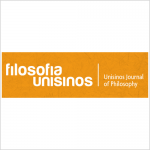Ver-como y Epistemología Hinge
Vol. 22. N.1 (2021): Jan-Apr • Filosofia Unisinos - Unisinos Journal of Philosophy
Autor: Maria Sol Yuan
Resumo:
El presente artículo tiene como objetivo establecer en qué sentido resultan justificables desde un punto de vista epistémico las proposiciones englobadas bajo el empleo percep- tual de ‘ver-como’, desarrollado por Wittgenstein en la Segunda Parte de Philosophical Investigations. Para ello, en primer lugar, se aclarará el vínculo interno entre ‘experiencia visual’ e ‘interpretación’ en la clase de casos mencionados. En segundo lugar, se mostrará cómo el ‘ver-como’ respeta la solución a la paradoja del seguimiento de reglas, en tanto no presupone ningún intermediario ni necesita alguno para dar cuenta de lo percibido, resaltando las nociones de ‘práctica’, ‘familiaridad’ y ‘contexto’ comunes tanto en la men- cionada solución como en los casos de ‘ver-como’. En tercer lugar, se recurrirá a la distinción general entre certezas o ‘hinges’ y ‘proposiciones’ de carácter epistémico presentada por Wittgenstein en On Certainty. Dicha distinción servirá para ubicar el caso de la percepción de aspectos presentes en los empleos de ‘ver-como’ como un posible campo de aplica- ción de la denominada Epistemología Hinge, mostrando cómo, en casos particulares, las certezas perceptuales que modelan nuestra forma de vida y que carecen de fundamento, pueden ser recontextualizadas y ameritar una justificación razonable.
Abstract:
This paper aims to stablishes the sense in which propositions included under the perceptual use of ‘seeing-as’, developed by Wittgenstein in the Second Part of Philosophical Investi- gations, are justifiable from an epistemic point of view. To do this, first, it will be clarified the internal link between ‘visual experience’ and ‘interpretation’ for the type of mentioned cases. Second, it will be shown how the ‘seeing-as’ respects the rule-following paradox’s solution, as long as it does not presuppose any intermediary or need anyone to account for what is perceived, highlighting the notions of ‘practice’, ‘familiarity’ and ‘context’ common both in the aforementioned solution and in the ‘seeing-as’ cases. Third, the general distinc- tion between certainties or ‘hinges’ and ‘epistemic propositions’ presented by Wittgenstein in On Certainty will be applied to cases of aspect perception as a possible field of appli- cation of the so-called Hinge Epistemology, showing how, in specific cases, the perceptual certainties that shape our way of life and that are groundless, can be recontextualized and merit reasonable justification.
ISSN: 1984-8234
DOI: 10.4013/fsu.2021.221.04
Texto Completo: http://revistas.unisinos.br/index.php/filosofia/article/view/fsu.2021.221.04/60748400
Palavras-Chave: Wittgenstein, percepción de aspectos, ver-como, ejes, certezas, justificación.

Filosofia Unisinos - Unisinos Journal of Philosophy
The journal Filosofia Unisinos - Unisinos Journal of Philosophy is published once every four months by Universidade do Vale do Rio dos Sinos.
Articles must be original, unpublished, and not under consideration for publication anywhere else and can be written in Portuguese, English or Spanish
Filosofia Unisinos - Unisinos Journal of Philosophy prints articles, translations and critical book reviews. It also reprints papers that are considered fundamental to the area when authorized written permission is given by the original publisher.
